To automate emotion in your tracks, you can creatively manipulate volume, filters, reverb, and effects with envelopes. Use volume envelopes to emphasize punchy starts or smooth fades, and shape filter parameters for mood shifts or tension. Automate panning and reverb decay to create immersive spatial dynamics. Modulate effects like distortion or saturation to evoke reactions. Layer and randomize envelope patterns for surprise and complexity—if you want more techniques to craft dynamic, emotional soundscapes, keep exploring further.
Key Takeaways
- Use ADSR envelope parameters to shape sound amplitude, creating expressive dynamics and emotional impact.
- Automate filter envelopes to craft evolving textures and dramatic mood shifts over time.
- Employ panning and reverb decay automation to enhance spatial movement and emotional storytelling.
- Apply envelope-driven sidechain effects for rhythmic breathing and dynamic energy flow.
- Incorporate randomized envelope modulation for spontaneous, unpredictable variations that evoke emotion.
Sculpting Vibrations With Volume Envelopes

When shaping the vibrations in your sound, volume envelopes play a crucial role. They allow you to control how a sound’s amplitude evolves over time, enabling precise vibration sculpting. By adjusting the attack, decay, sustain, and release parameters, you can craft dynamic energy or smooth progressions. Envelope shaping helps you emphasize specific moments, making sounds feel more alive and expressive. For example, a quick attack can create a punchy start, while a slow release adds a sense of fading or nostalgia. With careful manipulation, you turn static sounds into compelling movements, guiding the listener’s emotional experience. Mastering volume envelope techniques empowers you to craft vibrational textures that resonate deeply, adding a layer of automation to your sound design process.
Using Filter Envelopes to Shape Mood Changes
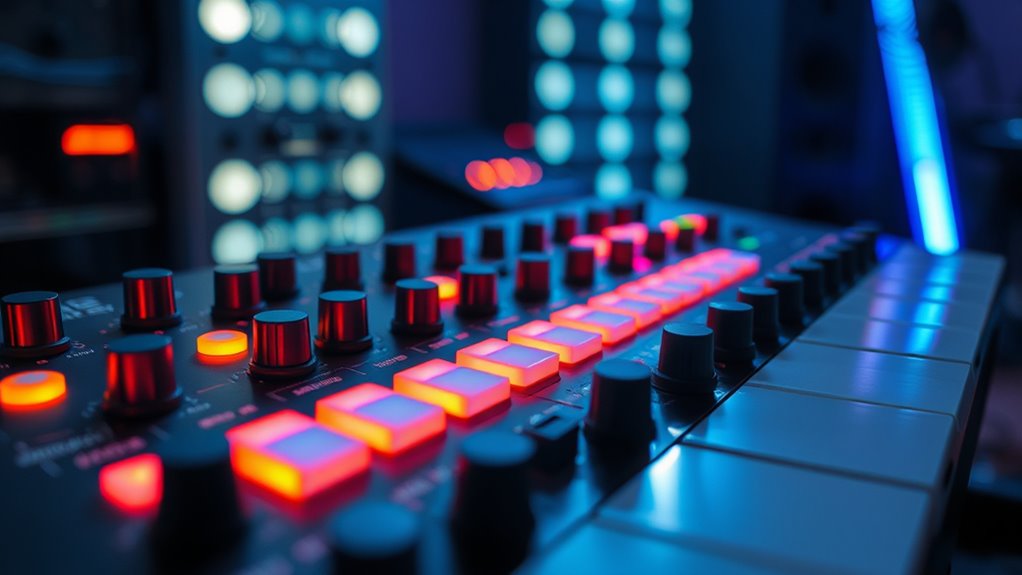
You can shape mood changes by adjusting filter envelope parameters, which control how the sound evolves over time. Dynamic filter sweeps allow you to craft smooth or dramatic shifts, enhancing emotional impact. Mastering mood transition techniques helps you create expressive and compelling soundscapes. Exploring personality traits can also inspire more nuanced and emotionally resonant sound design choices.
Envelope Parameter Controls
Envelope parameter controls allow you to dynamically shape the mood of a sound by manipulating filter envelopes. This technique enhances expression modulation and enables precise parameter automation, giving your tracks emotional depth. Adjust envelope settings like attack, decay, sustain, and release to control how the filter evolves over time, directly affecting the sound’s character. You can target specific parameters for automation, creating evolving textures and subtle shifts that reflect your artistic intent. Incorporating voiceover techniques can further add realism and emotional impact to your sound design.
Dynamic Filter Sweeps
Have you ever wanted to create dramatic shifts in your sound’s character? Dynamic filter sweeps using filter envelopes allow you to do just that, shaping vocal expression and melodic phrasing with precision. By automating filter parameters, you can smoothly move from bright, energetic tones to darker, more subdued ones, adding emotional depth. Imagine opening the filter to emphasize a powerful vocal moment or closing it to create a sense of intimacy. These sweeps respond to your envelope settings, giving you control over how quickly or gradually the mood shifts occur. Incorporating this technique helps you craft evolving textures that keep your listeners engaged, making your tracks feel more alive and emotionally compelling. It’s a simple yet powerful way to enhance expressive dynamics in your music. Understanding the psychological and cognitive benefits of music education can deepen your appreciation for how such expressive techniques impact listeners emotionally.
Mood Transition Techniques
Building on the expressive power of dynamic filter sweeps, mood shift techniques harness filter envelopes to craft smooth and impactful shifts in emotional tone. By modulating filter parameters over time, you can subtly alter vocal expression, making transitions feel organic and emotionally resonant. Use gentle envelope curves to gradually open or close filters, revealing or obscuring ambient textures that deepen the atmosphere. For example, a slow filter envelope can fade in a warm, intimate vocal tone, while a sharper envelope creates sudden tension or surprise. These techniques allow you to shape the mood without abrupt changes, ensuring the track flows seamlessly. Experimenting with filter envelope settings discloses endless possibilities for transforming static sounds into emotionally dynamic experiences. Understanding emotional support can also help guide the way you craft these mood transitions, making them more effective and meaningful.
Dynamic Panning for Moving Emotional Space

You can automate pan movements to match the evolving emotional landscape of your track, creating a more immersive experience. By syncing panning with track dynamics, you enhance the natural flow of emotion and tension. This technique keeps the listener engaged as the sound shifts seamlessly across the stereo field.
Automate Pan Movements
How can you guarantee that camera movements align seamlessly with the shifting emotional landscape of a scene? Panning automation is your answer. By precisely controlling pan movements over time, you can create dynamic stereo imaging that mirrors the scene’s emotional flow. Automating pan parameters allows the soundstage to move naturally, emphasizing key moments or subtle shifts. Use automation curves to gradually shift stereo imaging from left to right or to focus on specific elements, enhancing immersion. This technique ensures your audio dynamically responds to the narrative, making the listener feel more connected. Implement panning automation thoughtfully, avoiding abrupt changes, and let your tracks evolve organically with the scene’s emotional arc. In doing so, you craft a more engaging, emotionally resonant experience. Additionally, understanding the importance of sound design and how it interacts with scene mood can further elevate your work.
Sync With Track Dynamics
When the emotional tone of a scene shifts, aligning panning movements with the track’s dynamics guarantees your audio remains engaging and expressive. Use envelope modulation to match pan movements with the track’s vibrational resonance, creating a sense of movement that reflects emotional changes. As the music swells or quiets, adjust the panning to emphasize the emotional space, making it feel more immersive. By syncing your panning with dynamic peaks and troughs, you enhance the listener’s experience, making changeover feel natural and compelling. This technique assures your sound design adapts seamlessly to the evolving mood, maintaining emotional intensity. Leveraging envelope modulation for dynamic panning transforms static stereo images into expressive, moving soundscapes that resonate with your audience.
Enhance Emotional Flow
Building on the foundation of syncing panning with track dynamics, enhancing emotional flow involves actively guiding the listener’s sense of space to mirror shifts in mood. Use dynamic panning to reflect vocal expression, making the sound move in tandem with emotional intensity. For example, during a passionate melodic phrasing, pan the vocals subtly across the stereo field to convey movement and vulnerability. When the mood shifts to introspection, center the sound or gently shift it to create a sense of intimacy. This technique immerses listeners, making emotional shifts feel natural and organic. By carefully controlling panning in sync with melodic phrasing and vocal expression, you craft a dynamic space that elevates the emotional storytelling within your track. Additionally, considering the overall bedroom ambiance and decor can inspire a more authentic and emotionally resonant creative environment.
Automating Reverb Decay for Atmosphere Swells
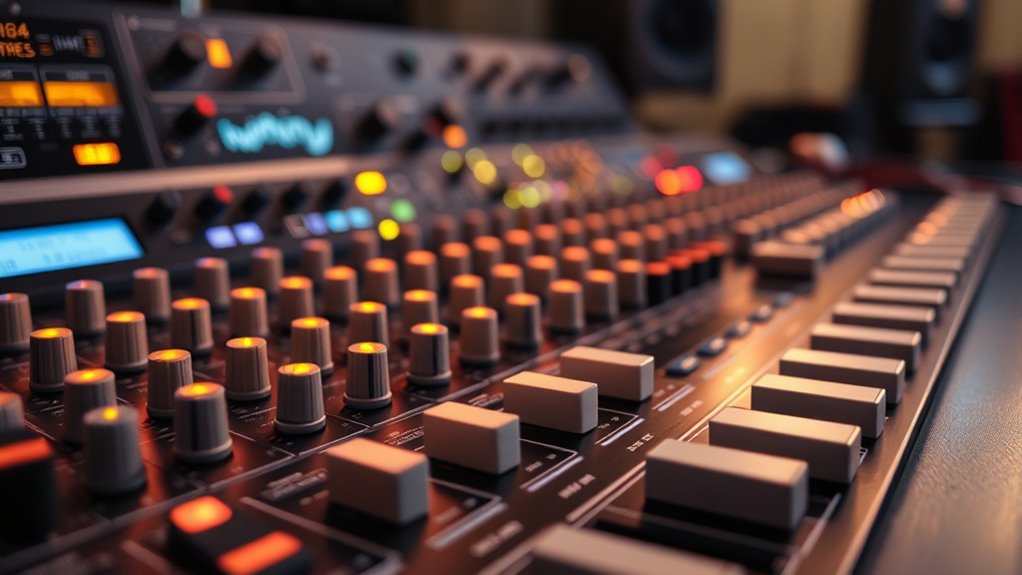
Automating reverb decay is essential for creating dynamic atmosphere swells that evolve seamlessly over time. By adjusting the reverb tail with decay automation, you can craft evolving soundscapes that breathe and shift naturally. Start by mapping the decay parameter to follow your track’s emotional arc, gradually lengthening the reverb tail during build-ups and shortening it during drops. This control allows the reverb to expand and contract, adding depth and movement to your mix. Focus on precise automation curves to avoid abrupt changes, ensuring the atmosphere feels organic. Understanding contrast ratio helps you appreciate how deep blacks and bright whites can enhance the perception of space and depth in your mix. With thoughtful decay automation, your soundscape progression smoothly, immersing listeners in a richer, more expressive environment that heightens emotional impact throughout your track.
Modulating Effects for Expressive Textures
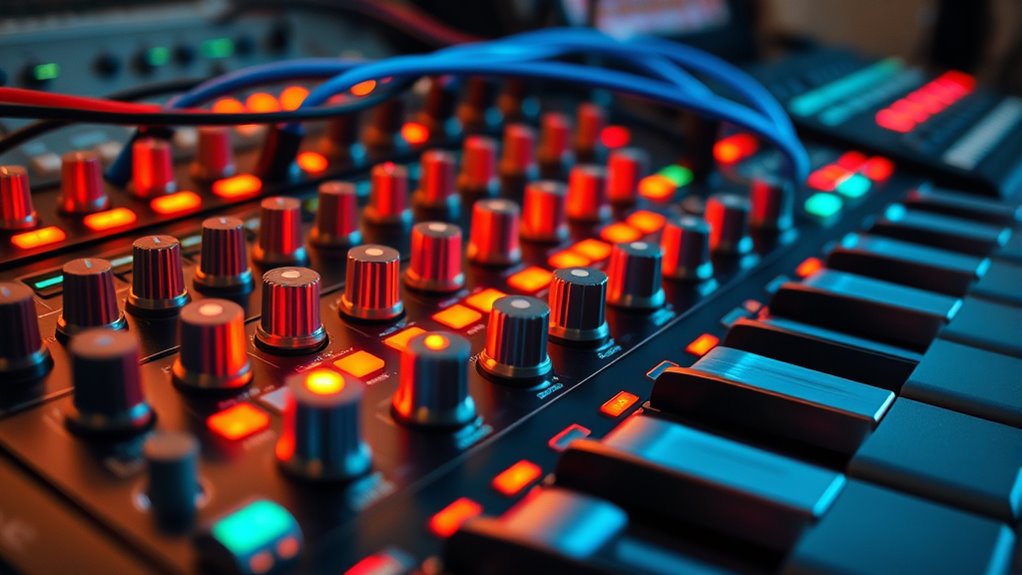
Modulating effects such as chorus, phaser, and flanger can dramatically enhance your track’s expressive textures by adding movement and variation. These effects tap into vintage techniques, creating warm, nostalgic sounds while allowing you to craft experimental textures that stand out. To get the most out of these effects: 1. Automate depth and rate parameters to evolve your sound dynamically. 2. Layer multiple modulation effects for complex, shifting textures. 3. Use subtle modulation to add warmth or more intense changes for experimental soundscapes. Incorporating crochet styles for locs techniques can also inspire creative modulation patterns, enriching your sound design process.
Creating Rhythm With Envelope-Driven Sidechain Effects
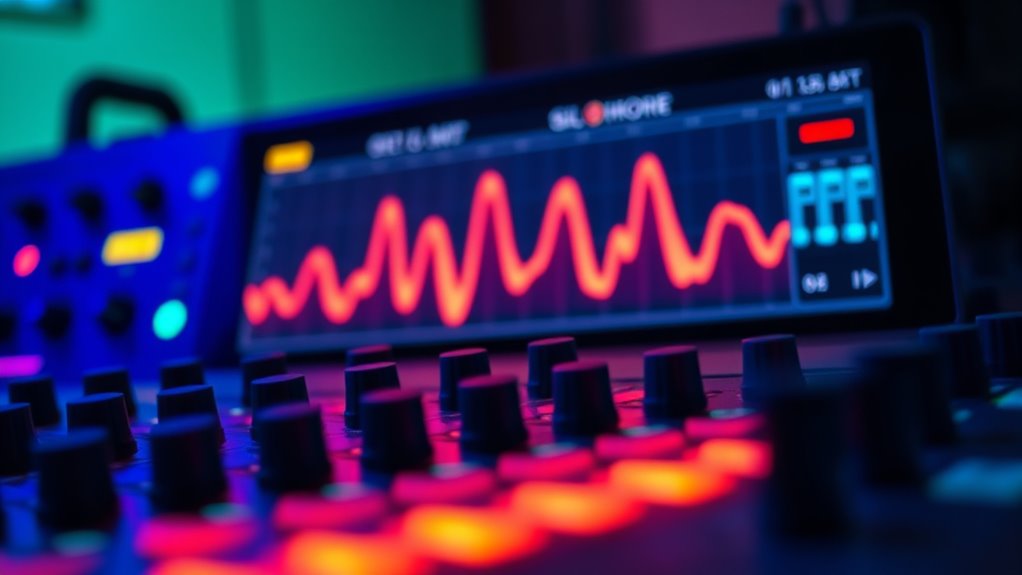
By applying envelope-driven sidechain effects, you can craft dynamic rhythms that breathe life into your tracks. These effects shape how elements interact, creating a sense of movement that enhances your musical storytelling. When you use carefully timed sidechain compression, you manipulate volume and energy flow, making your rhythm more engaging and compelling. This technique helps you capture your audience’s attention, guiding their emotional response through rhythmic pulses. With envelope automation, you can vary sidechain intensity, emphasizing specific parts of your track for maximum impact. The result is a groove that feels alive and intentional, drawing listeners deeper into your musical narrative. Technique mastery here transforms static sounds into lively, rhythmic conversations, elevating your production’s emotional depth. Additionally, understanding how decluttering your mixing space and tools can lead to more focused creativity and better workflow.
Applying Envelopes to Distortion and Saturation

You can shape the harmonic content of your sound by applying envelopes to distortion and saturation, making them more expressive. Dynamic tone control lets you emphasize or soften certain moments, giving your track more emotional impact. Experimenting with these techniques helps you craft a unique, responsive sound that evolves naturally.
Shaping Harmonic Content
Applying envelopes to distortion and saturation allows you to shape their harmonic content dynamically, creating more expressive and musical results. This technique enhances vocal expression and melodic phrasing by emphasizing certain harmonics at precise moments. To utilize this effectively, consider these steps:
- Automate the envelope to increase harmonic richness during key vocal phrases, adding emotion.
- Use sharp attack settings to accentuate the start of a note, emphasizing melodic phrasing.
- Modulate the release to smoothly blend harmonic changes, maintaining musicality throughout the track.
Dynamic Tone Control
Envelopes can be used not only to shape harmonic content but also to dynamically control the tone of distortion and saturation effects. By applying envelopes to these effects, you create expressive phrasing that responds to your musical cues. This technique allows you to craft emotional storytelling within your tracks, making them feel more alive and engaging. For example, you can subtly increase saturation during a chorus or soften distortion during a verse, enhancing the track’s emotional flow. Automating these parameters gives you precise control over tone changes, enabling you to evoke specific feelings at key moments. This dynamic tone control adds depth and personality, transforming static effects into expressive tools that mirror the emotional nuances of your performance.
Crafting Surprise With Randomized Envelope Modulation
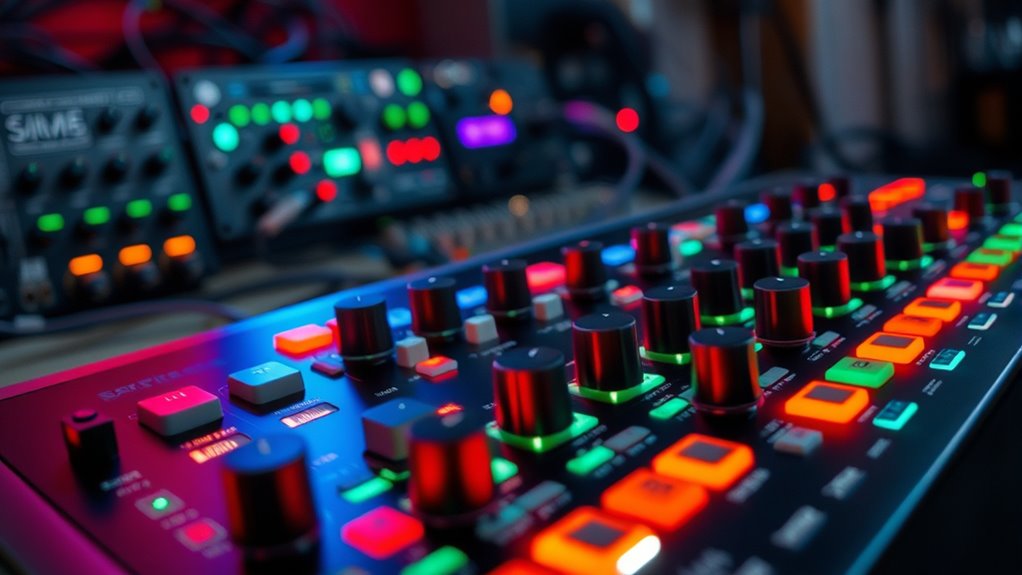
To create a sense of surprise in your audio, randomized envelope modulation introduces unexpected dynamics that catch the listener off guard. By leveraging generative randomness, you infuse your tracks with emotional unpredictability, making them feel alive and spontaneous. To effectively use this technique:
- Adjust the randomization parameters to control the degree of unpredictability.
- Sync envelope changes with musical cues for seamless integration.
- Experiment with different modulation sources to find unique, surprising effects.
This approach keeps your sound fresh and engaging, as each modulation cycle varies, preventing predictability. Randomized envelopes challenge traditional automation, delivering a dynamic, emotionally charged experience. Use this method to surprise your audience and evoke a more authentic, visceral response.
Layering Envelopes for Complex Emotional Transitions
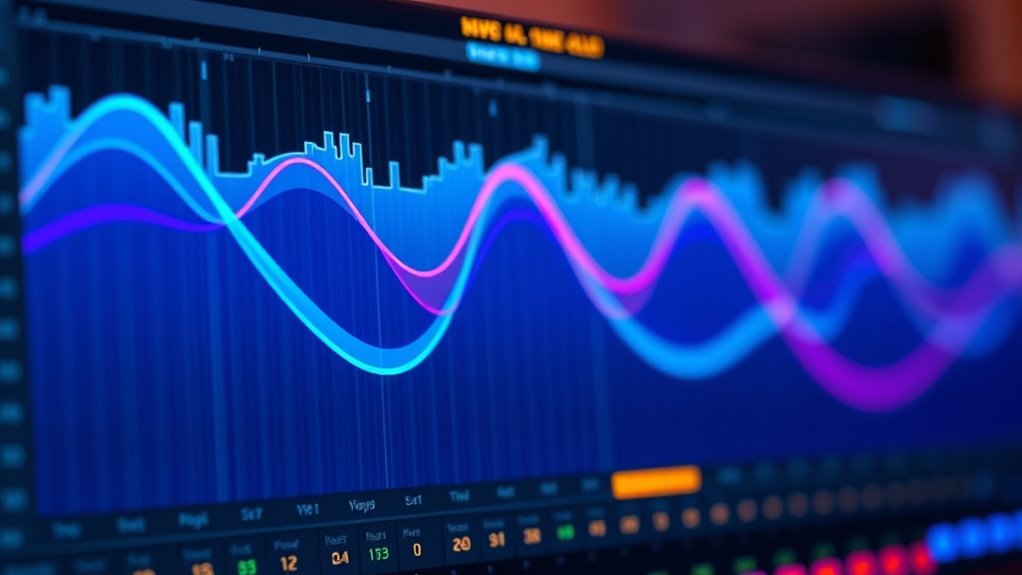
By layering multiple envelopes, you can craft intricate emotional shifts that evolve smoothly over time. This technique enhances vocal expressiveness by allowing you to shape dynamic nuances within a track. Emotional layering becomes more effective as you combine envelopes that control parameters like volume, filter, or pitch, creating a textured emotional landscape. For example, a gentle rise followed by a sudden dip can evoke vulnerability, while a slow build can heighten anticipation. You control the timing and intensity of each envelope, blending them to produce seamless transitions. This approach gives your music depth and natural flow, making emotional changes more compelling and believable. Mastering layered envelopes empowers you to evoke complex feelings, guiding listeners through a rich emotional journey.
Syncing Envelopes With Tempo for Cohesive Dynamics

When shaping complex emotional shifts through layered envelopes, aligning their timing with your track’s tempo guarantees that these changes feel natural and cohesive. To do this effectively, focus on beat matching and tempo mapping. First, use tempo mapping to set your project’s tempo accurately, ensuring your envelopes sync seamlessly with the rhythm. Second, adjust envelope points to match key beats or musical accents, reinforcing the groove. Third, leverage automation tools to align envelope curves precisely with tempo changes, maintaining dynamic consistency. By syncing envelopes with the beat, you create smooth progressions that resonate emotionally. This approach assures your dynamic shifts stay cohesive within the track’s rhythmic framework, enhancing listener engagement without disrupting the musical flow.
Frequently Asked Questions
How Can Envelope Automation Enhance Live Performance Dynamics?
Envelope automation boosts your live performance dynamics by allowing you to fine-tune expressive timing and dynamic panning in real-time. You can subtly adjust volume, filter sweeps, or stereo placement to match the energy and mood of your set. This creates a more engaging experience, making your performance feel alive and responsive. By carefully controlling these elements, you guarantee your audience stays captivated and your sound remains vibrant throughout your act.
What Are the Best Methods to Prevent Envelope Modulation From Sounding Unnatural?
Think of envelope modulation like painting with watercolors; too much can look unnatural. To prevent this, you should aim for natural transitions and subtle modulation, adjusting envelope curves gently. Use slow attack and release times to keep changes smooth, and listen closely to make sure movements feel organic. Experiment with small tweaks, much like refining brushstrokes, until your automation flows seamlessly, avoiding abrupt or robotic sounds.
Can Envelope Tricks Be Used to Simulate Human Vocal Expressions?
Yes, you can use envelope tricks to simulate human vocal expressions. By carefully shaping envelope modulation, you add dynamic nuances like vibrato, pitch bends, and emotional inflections, making your vocals sound more lifelike. You actively manipulate the attack, decay, and sustain parameters to mimic natural vocal changes, giving your track a more expressive and human touch. This technique enhances emotional depth and realism in digital vocals or processed sounds.
How Do Envelope Settings Influence Overall Mix Clarity?
You influence your mix’s clarity through envelope settings by using panning automation and volume shaping. Panning automation helps you position sounds precisely, reducing mud and enhancing separation. Volume shaping controls the dynamics and focus of each element, preventing clutter and ensuring clarity. By carefully adjusting these envelope parameters, you create a balanced, transparent mix where every sound is distinct, making your overall track feel polished and professional.
What Software Tools Are Most Effective for Complex Envelope Modulation?
When exploring software comparison for complex envelope modulation, you want tools that excel in precision, flexibility, and creative control. Effective software options like Ableton Live, FL Studio, and Bitwig Studio offer advanced modulation techniques, allowing you to shape dynamics creatively. These tools enable you to craft intricate envelope movements, making your tracks more expressive and engaging. Choose software that best aligns with your workflow to unseal the full potential of your modulation techniques.
Conclusion
Now, imagine the endless possibilities when you master these envelope tricks. Each subtle shift, each dynamic movement, can transform your track into an emotional journey listeners won’t forget. Are you ready to push boundaries and surprise your audience? The next step is yours—experiment, tweak, and let your creativity lead you into uncharted sonic territory. The moment to reveal your track’s true emotional power is just one envelope away.










